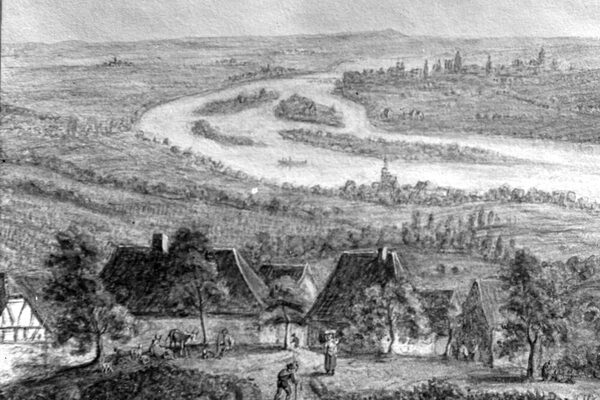Nürnberger Hof (Nuremberg Court)
After Frauenstein fell to the Archbishopric of Mainz, the Counts of Nassau established several farms around the town, including the Nuremberg Court in the east, in order to prevent the expansion of the now Mainz territory. In contemporary sources, the Nürnberger Hof is called Hof "Nornberg". This contains the word "norr", which means dry, barren in the local dialect. The Nuremberg Court is mentioned for the first time in a document from 1418, which was issued by Johann von Geispitzheim and his wife as fief holders of the Nuremberg Court. The farm with its wine press house and a meadow in Frauenstein are mentioned as accessories.
The main component of the Nürnberger Hof, which was located in the district of Schierstein, were its vineyards; the respective feudal holders always had to deliver a few barrels of wine from these to the Nassau residences in Wiesbaden and Idstein. In a sharing contract between the brothers Philipp zu Nassau-Wiesbaden and Adolf zu Nassau-Idstein, Adolf stipulated that four barrels of "Nornberger Gewächs" wine were to be delivered to the winery in Wiesbaden each year. Another important source of income was the Nuremberg court's sheep farm, which has been documented since the middle of the 16th century.
The estate was often leased to Nassau officials, but after the Thirty Years' War it temporarily fell to the Elector of Mainz. At that time, the estate consisted of 60 acres of arable land, seven large meadows and numerous fruit trees. The size of the vineyards is not disclosed on this occasion. At the beginning of the 19th century, Duke Friedrich August zu Nassau leased the Nürnberger Hof to his former personal chef and kitchen master Sebastian Kirn, who set up an excursion restaurant here; the most famous visitor was Goethe in 1815. In 1856, the Kirn family sold the estate on.
After several changes of ownership, the Nürnberger Hof, which at that time consisted of two residential buildings, a large wine cellar, wine press house, stables, barns and other outbuildings, 400 acres of land, including 17 acres of vineyards, became the property of the municipality of Frauenstein. The land was sold or leased, mostly to the inhabitants of the village. In 1928, the Nürnberger Hof was incorporated into Wiesbaden together with Frauenstein. Today it is a popular excursion destination.
Literature
Strauß, Harald: Local history book Wiesbaden-Frauenstein, Wiesbaden-Frauenstein 1998.
